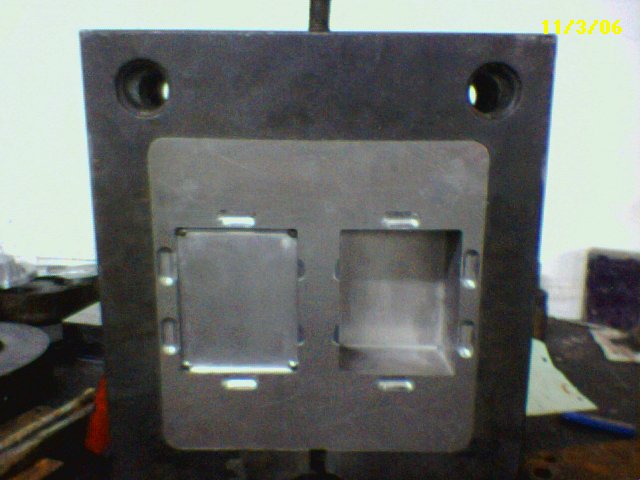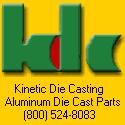What is a Better Alloy–Magnesium or Aluminum? Die casting is being hailed as one of the better innovations to come along in the manufacturing industry. Its contributions are very important – cheaper production costs and shorter production times. As such, …
Continue reading
Category Archives: Tooling Die Casting
We Honor Competitors Parts Prices on Transfer Tooling
Faster and better Aluminum Die Casting Parts and Zinc Die Casting Parts, No risk to you. Transfer your die casting tooling with a PO and we will match the part prices. You will get great quality parts in 4 weeks or less. Send your die casting tooling, molds and trim dies to Kinetic Die Casting Company with a die casting part (PO) purchase order. We will honor our competitors die casting part prices and ship you great quality die casting parts in less than 4 weeks.
We are still offering a Tooling Transfer special. When another die casting company fails to do a good job. Fails to ship good quality die casting parts. Fails to ship aluminum die castings on time. The manufacturing company customer transfers their die casting tooling to Kinetic Die Casting Company, a better die casting part supplier.
Kinetic Die Casting Company makes that decision easier this week.
1. Send us your die casting tooling and die casting molds
2. A purchase order made to us with your old suppliers prices.
3. We will honor the die casting part price paid to the old die casting part supplier.
4. You will get better die casting parts than you received before.
5. We will ship the die casting parts to you in less than 4 weeks.
Kinetic Die Casting Company 6918 Beck Avenue North Hollywood California 91605 USA
Office Hours: Monday through Thursday 6:00 AM to 4:30 PM (Pacific Time)
818-982-9200 – sales@kineticdc.com – www.kineticdiecasting.com

Die Casting Part Prices
“The Parts We Make Today, We Ship Today”
Kineticdc makes:
Automotive Die Casting Parts
Airplane Die Casting Parts
Light Fixture Die Casting Parts
Consumer Products Aluminum Parts
Aerospace Die Casting Parts
Military Die Casting Parts
Transfer Tooling
Transfer your die casting tooling to Kinetic Die Casting without risk – We are offering a Tooling Transfer special this week. Send us your die casting tooling, mold and trim die, with a valid purchase order and we will honor our competitors die casting part prices and ship you great quality die casting parts in less than 4 weeks.
When another die casting company fails to do a good job. Fails to ship good quality die casting parts. Fails to ship parts on time. The manufacturing company customer transfers their die casting tooling to Kinetic Die Casting Company, a better die casting part supplier.
Kinetic Die Casting Company makes that decision easier this week.
1. Send us your die casting tooling and
2. A purchase order made to us with your old suppliers prices.
3. We will honor the price paid to the old die casting part supplier.
4. You will get better parts than you received before.
5. We will ship the parts to you in less than 4 weeks.
Kinetic Die Casting Company 6918 Beck Avenue North Hollywood California 91605 USA
Office Hours: Monday through Thursday 6:00 AM to 4:30 PM (Pacific Time)
818-982-9200 – sales@kineticdc.com – www.kineticdiecasting.com

Die Casting Part Prices
“The Parts We Make Today, We Ship Today”
Kinetic Die Casting Company on Facebook
![]() Today, we are reminding everyone that Kinetic Die Casting Company is on Facebook Take the time to go to our Facebook page and “Like Us” Our Facebook Page is updated every week with offers to get Homemade Almond Roca and other items pleasing to most people. We post pictures of die casting parts and we post links to web sites that we believe will benefit our followers.
Today, we are reminding everyone that Kinetic Die Casting Company is on Facebook Take the time to go to our Facebook page and “Like Us” Our Facebook Page is updated every week with offers to get Homemade Almond Roca and other items pleasing to most people. We post pictures of die casting parts and we post links to web sites that we believe will benefit our followers.
You will know you are on our page http://www.facebook.com/Kineticdc when you see our motto in the header “The Parts We Make Today, We Ship Today”. Go to our page and click the like button and give us a 5 star rating (*****).
As of today, (May 20, 2015) we have 476 Facebook Page likes. Like the page and we will be happy to like your page in return. If you have something relevant to say, make a comment. As always, we will be happy to supply your manufacturing company with die casting parts produced quickly and at great quality.
Thank you for reading our Kinetic Die Casting Company Blog
Kinetic Die Casting Company (www.kineticdc.com)
6918 Beck Avenue
North Hollywood, CA 91605
818-982-9200
sales@kineticdc.com
Aluminum die casting parts, zinc die casting parts and die casting tooling for all manufacturing industries including automotive parts, lighting parts, military parts, aerospace parts, and many more.
#kineticdc #manufacturing #diecasting #facebook #diecastingcompany
Kinetic Die Cast Mold Bases Available
Die Cast mold bases are used to fit customer owned inserts into a die casting machine. KineticDC has several Die Casting Tooling Mold Bases that we use to produce aluminum die casting parts. These die cast mold bases are convenient for use for customers who own die casting tooling inserts but not a die cast mold base to use in a die casting machine. Some of the mold bases we own are as small as 12″ by 12″ and are as large as 36″ by 36″. Kineticdc also has DME unit die holders and MUD bases. DME unit dies are available in many sizes. Kinetic Die Casting primarily uses two DME Unit Die sizes:
Kinetic Die Casting will mount “customer owned” die cast tooling inserts into our mold bases so we can produce aluminum die casting parts. We can mount inserts ranging in sizes from 3″ to 20″ and all sizes in between. If a customer contacts us and they own die casting tooling inserts only, we can make parts for them. We have also made die cast tooling inserts for customers that will fit our mold bases. The tooling inserts are many types, like:

Die Casting Tooling is the greatest cost barrier to producing aluminum die cast Custom Metal Parts. The die cast die mold base is a very large percentage of the die cast tool cost. Kinetic Die Casting uses our die casting mold bases to save money for our customers, so they can get the die casting parts they need.
Kinetic Die Casting Company has Die Cast Mold Bases Available
Do you need a mold base to fit your die casting insert? Know someone that wants to buy die cast parts and can use our die casting services?

Call us and let us know 818-982-9200.
Kinetic Die Casting Company 6918 Beck Avenue North Hollywood California 91605
www.kineticdc.com #diecasting #kineticdc #manufacturing @kineticdc #moldbases #tooling

